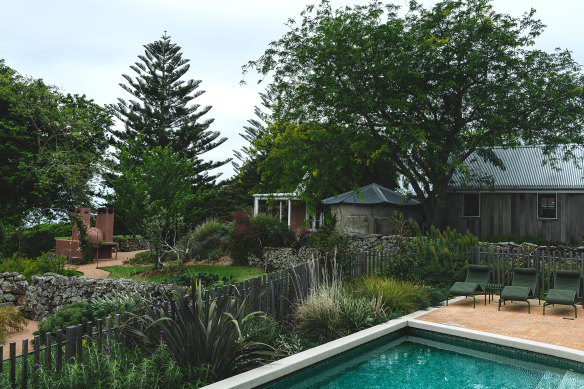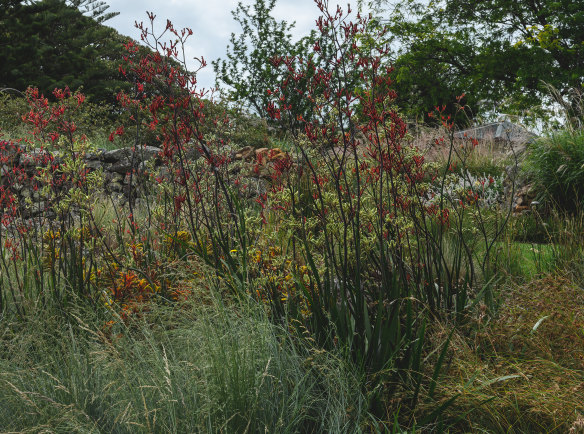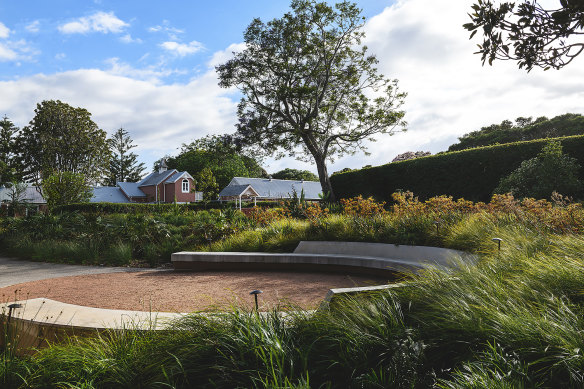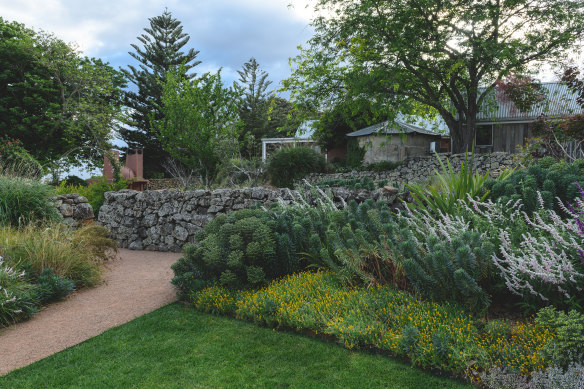Dilapidation and delight: An 1880s dairy turned award-winning garden
“Wild, rambling beauty with a rainforest-meets-genteel-cottage-garden vibe”. This is how Kirsty Kendall describes the mood she and fellow landscape architect Emily Simpson encountered when they began working on the sprawling estate of Greyleigh.
Endemic figs and palms were flourishing alongside weathered stone walls. There were neglected, woody hedges teeming with birdlife. They found heritage fruit trees, interesting bulbs, old aloes and, behind one particularly overgrown planting, a “secret” garden with a bowerbird nest.
Everywhere they turned there was both dilapidation and delight.

The Greyleigh garden, which has just taken out an award from the Australian Institute of Landscape Architects.Credit: Owen Hall
All of which is to say there was nothing regular about this historic property on the NSW South Coast, which won an award of excellence in the gardens category at the 2024 National Landscape Architecture Awards last week.
But what Kendall and Simpson did with this garden – which the institute described as harmonious, ecologically diverse, thoughtful and clever – provides lessons for all gardeners.
Even those with small urban spaces can glean ideas from how Simpson and Studio Rewild’s Kendall amplified what was already at this property, which was established as a dairy in the 1880s.
While most gardens don’t come with such atmospheric starting points as Greyleigh, Kendall’s advice to all gardeners is to closely observe your patch and, when relevant, consider how it sits in the wider landscape before doing anything.
In the absence of obvious features that might be used as starting points, Kendall suggests taking your cue from your soil and the plants that hail from your area. “Research the local endemic flora, visit local nurseries and spend time bushwalking. The more you look at natural landscapes the more of a sense you get of how plants go together. Then build on that,” she says.

Loose plantings weave around stone walls.Credit: Owen Hall
Just as Kendall and Simpson have retained original plantings and added endemic rainforest species, as well as plants from further afield at Greyleigh. Kendall suggests people mix local plants with other Australian plants, edibles, succulents, perennials and other exotics.
“I love an eclectic mix,” she says. “Even on a little balcony.”
She advises selecting a diversity of plants that you find pleasing, enhance biodiversity and create habitat for butterflies, birds and bees.
While she encourages people to choose plants that will stand up to climate change and the sort of weather extremes that are becoming increasingly common, she says there will always be some plants that fail to thrive.
“Gardening is a constant process of adding and editing – don’t be scared to try things,” Kendall says.

There is a careful balance between a sense of expansiveness and a sense of enclosureCredit: Owen Hall
Her preference is for gardens that “don’t feel like they are really designed”, places with a sense of looseness, rather than those that are overly neat.
But as all gardeners know, it can be difficult to create well-considered spaces that don’t suggest the design hand behind them. The passage of time almost always helps. Newly planted spaces rarely feel as good to be in as those spaces where the plants have started to stretch out or self-seed or otherwise make themselves at home.
For the best results, Kendall advises people to consider the height, texture and colour of their plants and to use them in a way that creates a sense of harmony.
“We have a very long species list in our planting design [at Greyleigh] but they are not used so that it looks like a wild mess. Everything is considered.”
Kendall says it is also important to find the right balance between the sense of enclosure and expansiveness.

Kirsty Kendall and Emily Simpson have worked to amplify the mood that they first found in the garden.Credit: Owen Hall
While some parts of the Greyleigh garden overlook open pasture, more screening is usually required in the inner city. Bamboo is one of the go-to options thanks to how fast-growing and dense it is, but Kendall’s preference is for a mix of different plants (for example in warm areas a mix of blueberry ash and Cordyline stricta) that enrich biodiversity.
But before you get too specific with your choices, Kendall tells gardeners to consider a place throughout every season.
“Then you get an understanding of how the light works, where you will want to take your winter coffee, where you want to block out the hot summer sun. Your ideas change so much from being in a place, from seeing the differences between the garden in the morning and the afternoon, from seeing where the breezes come from.”
You might not have a garden as big as Greyleigh, but you can have big ideas all the same.
Make the most of your health, relationships, fitness and nutrition with our Live Well newsletter. Get it in your inbox every Monday.